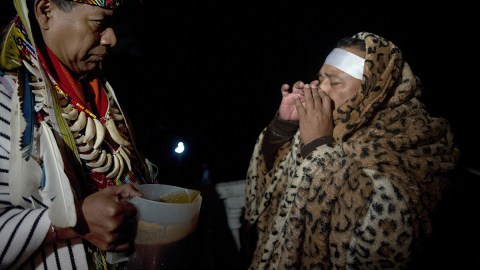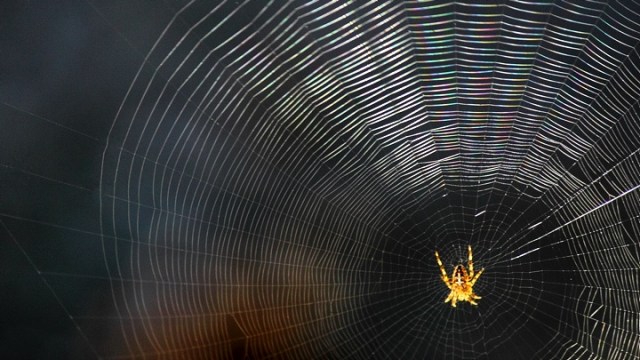From Ayahuasca to Psilocybin, Why Bad Trips Are a Good Thing

The mushroom covers a length from my middle finger to the edge of my palm. At eight grams it is a beautiful specimen. Carefully I slice it in half, handing one four-gram chunk to my friend, Brandon. We light a joint, wolf down our halves quickly, chasing it with smoke and water. It’s 10:45 pm.
At 11:15 we’re walking down Somerset St toward a Halloween party. Passing Robert Wood Johnson University Hospital, Brandon turns to me: “I need to go in there.” I tell him we can’t; my college job is in the emergency room monitoring suicidal patients. I’m not ready to accept that we’re two of them.
But he’s not feeling social. He heads to his dorm while I hit up the party. Two hours later I’m back in my apartment, realizing that my trip has barely begun. Seeking some semblance of reality, I walk into my roommate’s room, flip on his Sega Genesis, and start playing Crash Bandicoot. I can’t make it past the first stage: I keep dying, and being reborn. And dying. And reborn.
Then it all comes crashing down.
In the bathroom I recall a concept, like my name. I envision a small circuit board operator inside my head unplugging that line. She keeps ripping wires any time I think of a word. Then I get to ‘breathe.’ No, my mind yells, don’t forget that one! I rush into my bedroom, dive under the covers. The heating system is broken; it’s forty degrees outside. I forget my name around two am. At six, I remember, and pass out.
When I wake up three hours later, I vow to never eat another mushroom.
The following Friday, I eat two grams by myself, head to Voorhees Mall, sit on the grass for hours, meditate and think. I have the trip of my life.
A bad trip often keeps people away from psychedelics, such as the psilocybin mushrooms we ingested that evening. As it turns out, four grams is the amount that pushes people over the edge, a new study shows. Since that night I’ve never ingested that much, and have no plans to. But as the research also states, a bad trip can be a very good thing.
Eighty-four percent of people who have experienced bad psilocybin trips report that they benefited from it. As someone who has experimented with a wide range of psychedelics, I’ve never enjoyed bad trips when they’re happening, but I’ve always learned from them. There is nothing mystical about these plants. You’re merely bringing to the surface latent issues already simmering around the edges. Where you’re at is where you’re going to end up during the trip.
And such trips will only increase as psychedelics continue to boom. This week’s New Yorker features an in-depth article on ayahuasca, showing just how far a South American DMT-laden tea has come in the last few decades in American consciousness. Ariel Levy writes,
If cocaine expressed and amplified the speedy, greedy ethos of the nineteen-eighties, ayahuasca reflects our present moment—what we might call the Age of Kale. It is a time characterized by wellness cravings, when many Americans are eager for things like mindfulness, detoxification, and organic produce, and we are willing to suffer for our soulfulness.
My three ayahuasca experiences have been extraordinarily peaceful, giddy even, though twice someone went down hard, which does not make for pleasant viewing. Levy concludes with her first journey, which sounds like nothing I’d want to partake in. (I’d say the shaman was unable to hold the ceremony together—a case of a ‘yogahuasca’ in charge.)
Levy’s strongest reporting is on the neurological impact of ayahuasca, which translates similarly across the psychedelic sphere. Evidence of these substances curbing alcoholism and other addictions and helping people deal with end-of-life care as well as psychological diseases such as depression and anxiety make this an exciting and potent area of research. Bad trips often occur due to the quieting of our brain’s daydreaming center, of which Levy writes,
Having studied fMRIs and EEGs of subjects on ayahuasca, [researcher Draulio de] Araujo thinks that the brain’s “default-mode network”—the system that burbles with thought, mulling the past and the future, while your mind isn’t focused on a task—is temporarily relieved of its duties. Meanwhile, the thalamus, which is involved in awareness, is activated. The change in the brain, he notes, is similar to the one that results from years of meditation.
This shutting down is not everyone’s cup of tea. In a hilarious skit, Louis CK talks about that invisible ‘forever empty’ inside all of us. Instead of coming to terms with this inherent loneliness regarding the inevitable transiency of life, we mindlessly flick through social media streams any time a potential moment of boredom arises. It’s not only memory that’s been outsourced to our phones; imagination too is deadened by our insistent business.
This, I would venture, is when a ‘bad trip’ occurs, when you’re reminded of your fleeting insignificance and unavoidable end to this life. Such a revelation is terrifying to a mind insistent that the world be otherwise. Countless gods and afterlives have been dreamt up to rage against this machine we call nature. Funny that they too are the product of an overactive imagination we struggle to suppress by staying ‘connected’ every moment of every day.
But there is much beauty to be gained during a psychedelic ritual precisely because you’re thrust into the present moment and whatever is going on in your thoughts. This is why I returned seven days after the worst trip of my life, to remind myself that it’s not the substance but my mind—the emotional and psychological processing power of my brain—that needed perspective. And that, I’m guessing, is why 84 percent of respondents claim bad trips are beneficial.
The philosopher Alan Watts noticed that the God of the West is a very stern and angry fellow while the gods of the East are always laughing and dancing. All these divinities are products of our imagination; we only suffer when pretending they actually exist. Their symbolism is more telling anyway: live in fear and dread or ride along the cosmic ocean to see what waves you catch. That decision is up to each of us, and it makes me look forward to whatever trip comes next.
—
Derek Beres is working on his new book, Whole Motion: Training Your Brain and Body For Optimal Health (Carrel/Skyhorse, Spring 2017). He is based in Los Angeles. Stay in touch on Facebook and Twitter.





